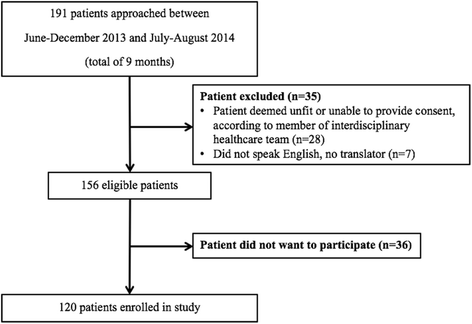Measuring frailty in clinical practice: a comparison of physical frailty assessment methods in a geriatric out-patient clinic
- PMID: 29132301
- PMCID: PMC5683585
- DOI: 10.1186/s12877-017-0623-0
Measuring frailty in clinical practice: a comparison of physical frailty assessment methods in a geriatric out-patient clinic
Abstract
Background: The objectives of this study were to determine: 1) the prevalence of frailty using Fried's phenotype method and the Short Performance Physical Battery (SPPB), 2) agreement between frailty assessment methods, 3) the feasibility of assessing frailty using Fried's phenotype method and the SPPB.
Methods: This cross-sectional study was conducted at a geriatric out-patient clinic in Hamilton, Canada. A research assistant conducted all frailty assessments. Patients were classified as non-frail, pre-frail or frail according to Fried's phenotype method and the SPPB. Agreement among methods is reported using the Cohen kappa statistic (standard error). Feasibility data included the percent of eligible participants agreeing to attempt the frailty assessments (criterion for feasibility: ≥90% of patients agreeing to the frailty assessment), equipment required, and safety considerations. A p-value of <0.05 is considered significant.
Results: A total of 110 participants (92%) and 109 participants (91%) agreed to attempt Fried's phenotype method and SPPB, respectively. No adverse events occurred during any assessments. According to Fried's phenotype method, the prevalence of frailty and pre-frailty was 35% and 56%, respectively, and according to the SPPB, the prevalence of frailty and pre-frailty was 50% and 35%, respectively. There was fair to moderate agreement between methods for determining which participants were frail (0.488 [0.082], p < 0.001) and pre-frail (0.272 [0.084], p = 0.002).
Conclusions: Frailty and pre-frailty are common in this geriatric outpatient population, and there is fair to moderate agreement between Fried's phenotype method and the SPPB. Over 90% of the patients who were eligible for the study agreed to attempt the frailty assessments, demonstrating that according to our feasibility criteria, frailty can be assessed in this patient population. Assessing frailty may help clinicians identify high-risk patients and tailor interventions based on baseline frailty characteristics.
Keywords: Frailty; Fried; Geriatric medicine; Out-patient; Phenotype; Short performance physical battery (SPPB).
Conflict of interest statement
Ethics approval and consent to participate
The entire study protocol was approved by the Hamilton Integrated Research Ethics Board (HiREB). All participants or legally authorized representatives signed the informed consent form prior to participation.
Consent for publication
Not applicable.
Competing interests
JP, CK, SK, GI, TW, CP, BM, SM and AP have no competing interests to declare.
Publisher’s Note
Springer Nature remains neutral with regard to jurisdictional claims in published maps and institutional affiliations.
References
Publication types
MeSH terms
LinkOut - more resources
Full Text Sources
Other Literature Sources


